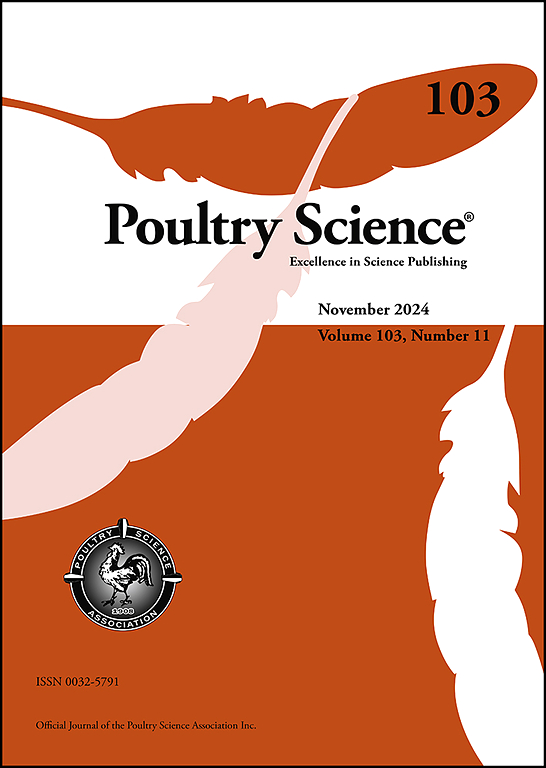皖西白鹅卵巢在筑巢和产蛋后期的造血功能、组织学特征和转录组谱分析。
IF 3.8
1区 农林科学
Q1 AGRICULTURE, DAIRY & ANIMAL SCIENCE
引用次数: 0
摘要
本文章由计算机程序翻译,如有差异,请以英文原文为准。
The hematopoietic function, histological characteristics, and transcriptome profiling of Wanxi white geese ovary during nesting and late-laying stages
Despite several factors influencing reproduction in geese, but the precise molecular mechanisms of egg cessation are not fully understood. In the present study, the hematopoietic parameters and serum hormone levels in Wanxi white geese were analyzed. RNA-Seq was utilized to identify the differentially expressed mRNAs (DEGs) and lncRNAs (DE lncRNAs) in the ovarian tissues associated with nesting in geese during the late-laying and nesting periods. Triglyceride (TG) and alkaline phosphatase (ALP) levels were higher in late-laying geese, while white blood cell (WBC), neutrophil (NEU), hemoglobin (HGB), and hematocrit (HCT) levels were significantly lower in late-laying geese. Serum levels of luteinizing hormone (LH), estrogen (E2), and progesterone (P4) increased significantly during the late-laying period, whereas prolactin (PRL) level was lower in the late-laying period than the nesting period. During the late-laying period, geese had a clear follicular hierarchy, with ovaries exhibiting mature and primary follicles. In the nesting period, the ovaries were degenerated and had many primary follicles without follicular development. Analysis of mRNA-lncRNA expression revealed 1,257 DEGs between the nesting and the late-laying stages, of which 841 were up-regulated and 416 were down-regulated DEGs. A total of 340 DE lncRNAs were identified between the nesting and the late-laying periods, with 113 being up-regulated and 227 down-regulated lncRNAs. DEGs, including TMEM, DRD3, IGFBP7, MAPK13, GnRHR2, HECTD3, KCNU1, OPRD1, and VCAM1, along with DE lncRNAs, including XR_001203613.1, XR_001206155.1, XR_001207759.1, XR_001213571.1 and XR_001214368.1 participate in reproduction in geese. Correlation analysis indicated that the cis-regulation of XR_001213096.1-ITPR3, XR_001203613.1-GALNT15, XR_001206155.1-COL6A3, XR_001207759.1-ANKS1B, and XR_001214368.1-VPS45 participate in the molecular mechanisms underlying nesting in geese. Functional enrichment analysis revealed the DEGs and DE lncRNAs associated with focal adhesion, extracellular matrix (ECM)-receptor interaction, cell adhesion molecules (CAMs), and PI3K-Akt signaling pathways, were responsible for the differences in the ovaries between the nesting and late-laying periods. This study offers valuable information on the roles of genes and lncRNAs, and the mechanisms underlying variations in reproductive performance between the late-laying and nesting periods.
求助全文
通过发布文献求助,成功后即可免费获取论文全文。
去求助
来源期刊

Poultry Science
农林科学-奶制品与动物科学
CiteScore
7.60
自引率
15.90%
发文量
0
审稿时长
94 days
期刊介绍:
First self-published in 1921, Poultry Science is an internationally renowned monthly journal, known as the authoritative source for a broad range of poultry information and high-caliber research. The journal plays a pivotal role in the dissemination of preeminent poultry-related knowledge across all disciplines. As of January 2020, Poultry Science will become an Open Access journal with no subscription charges, meaning authors who publish here can make their research immediately, permanently, and freely accessible worldwide while retaining copyright to their work. Papers submitted for publication after October 1, 2019 will be published as Open Access papers.
An international journal, Poultry Science publishes original papers, research notes, symposium papers, and reviews of basic science as applied to poultry. This authoritative source of poultry information is consistently ranked by ISI Impact Factor as one of the top 10 agriculture, dairy and animal science journals to deliver high-caliber research. Currently it is the highest-ranked (by Impact Factor and Eigenfactor) journal dedicated to publishing poultry research. Subject areas include breeding, genetics, education, production, management, environment, health, behavior, welfare, immunology, molecular biology, metabolism, nutrition, physiology, reproduction, processing, and products.
 求助内容:
求助内容: 应助结果提醒方式:
应助结果提醒方式:


